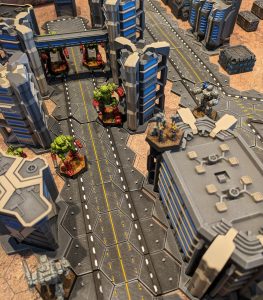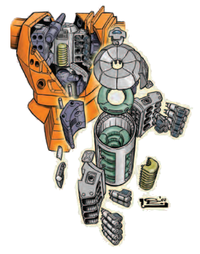Fusion engine
Sarna News

- HEXTECH Review - Wave 3 Brings More Urban Options To Your Battlefield
- Your BattleTech News Round-Up For March, 2024
- Crashing 'Mechs With Jennifer Brozek, Author Of The Rogue Academy Trilogy
- Getting The Word Out With Rem Alternis, Catalyst Community & Marketing Director
- Bad 'Mechs - Yeoman
- Read more →

Fusion engines are the most common type of BattleMech and aerospace power plant in the BattleTech Universe. Fusion engines can supply great quantities of power, enough for massive vehicles and all of their weapon systems, including the directed energy weapons common on modern battlefields. When no thrust is generated, fusion engines are extremely efficient, practically never needing refueling. If properly ventilated, controlled fusion reactions generate little heat. There are several sub-types of fusion engines available as well, each trading bulk for mass of the components.
Description[edit]
The fusion engine is capable of powering 'Mechs, Aerospace Fighters, and other vehicles. Fusion engines function by harnessing the power of a fusion reaction, as occurs in the core of the Sun. A BattleMech's fusion engine can usually last for decades on a few kilograms of hydrogen. Unlike the research reactors of the real world, a BattleMech's fusion engine runs on "light" hydrogen, protium, rather than hydrogen's heavier isotopes deuterium and tritium. [1]
Fusion engines are able to generate a great deal of heat. Simply moving the vehicle creates heat, though this is often a small amount. Though heat can negatively affect the vehicle's pilot or even the vehicle itself, a well-ventilated fusion engine is far less dangerous than the bleed-heat generated by charging and/or firing weapons, especially lasers and particle weapons.
In a BattleMech, the fusion engine resides in the center torso. It cannot be relocated elsewhere in the BattleMech, though certain types of engines may intrude into adjacent spaces within the structure.
Fusion engines, like other engines, are defined by their "engine rating". For 'Mechs, the engine rating is the mathematical product of the mass of the vehicle and its desired maximum walking or cruising velocity. Stated another way, a 'Mech's maximum walking momentum is directly proportional to engine rating. For instance, a 30-ton Spider BattleMech with a 240 Pitban fusion engine is able to generate the same maximum momentum as a 60-ton Merlin with the same engine, but because the Merlin's mass is twice that of the Spider, the Spider's maximum velocity is twice that of the Merlin.[2][3]
Combat Vehicles adjust engine rating calculation slightly based on motive suspension system. Additionally, engine rating is not proportional to engine mass; engine mass increases exponentially depending upon rating[4]. This results in light, low-to-moderately rated engines massing a disproportionately small fraction of larger engines. As a 'Mech's mass increases, a much larger proportion of the mass must be devoted to engine mass, or speed must be sacrificed. For instance, all of the following BattleMechs have the same maximum cruising (walking) velocity (43.2 km/h), but their varying mass means each 'Mech mounts a different engine. BattleMech mass, engine rating, engine mass, and (engine mass)/(BattleMech mass) are listed for each example, and increase together: PNT-9R Panther (35, 140, 5, 14%)[5], WTH-1 Whitworth (40, 160, 6, 15%)[6], BJ-1 Blackjack (45, 180, 7, 16%)[7], CN9-A Centurion (50, 200, 8.5, 17%)[8], MLN-1A Merlin (60, 240, 11.5, 19%)[9], CPLT-C1 Catapult (65, 260, 13.5, 21%)[10], GHR-5H Grasshopper (70, 280, 16, 23%)[11], ON1-K Orion (75, 300, 19, 25%)[12], VTR-9B Victor (80, 320, 22.5, 28%)[13], BLR-1G BattleMaster (85, 340, 27, 32%)[14], CP-10-Z Cyclops (90, 360, 33, 37%)[15], BNC-3E Banshee (95, 380, 41, 43%)[16]
For 'Mechs, larger fusion engines allow larger maximum momenta. But the inherent instability of bipedal locomotion requires a means to maintain balance and correct falls. In order to maintain control, 'Mechs also mount Gyros, which vary in size proportionally to engine rating.
Fusion engines usually will only shut down if damaged or if heat is uncontrolled. Unlike popular belief, there is absolutely no risk of a fusion engine accidentally becoming a nuclear weapon. [17] There have been a number of cases of fusion engines being "over revved" and exploding with devastating force, but this is more akin to a boiler explosion than a true nuclear explosion. More often a destroyed engine will be punctured by weapons fire. Because the plasma is held in a vacuum chamber (to isolate the superheated plasma from the cold walls of the reactor; contact with the walls would super-chill the plasma below fusion temperatures), a punctured reactor can suck in air where the air is superheated. Normal thermal expansion of the air causes the air to burst out in a brilliant lightshow often mistaken for a "nuclear explosion". This thermal expansion damages anything within 90 meters of the destroyed 'Mech.
Such dramatic failures are rare, though. It is difficult to sustain the fusion reaction and very easy to shut down. Safety systems or damage to containment coils will almost always shut down the engine before such an explosion occurs. The massive shielding of the engine (in the case of standard fusion engines, this is a tungsten carbide shell that accounts for over 2/3 of the weight of the engine) usually buys the safety systems the milliseconds needed to shut down the engine when severe damage is inflicted.
History[edit]
Fusion technology was achieved by the Western Alliance in 2021.[18] Almost a century later, fusion technology had progressed to the point of using protium, the most abundant isotope of hydrogen.[1]
Research into fusion engine technology has yielded improvements over the many centuries of BattleMech use. Light, extralight, and compact fusion engines are now available, in addition to the standard military version.
Brands[edit]
Fusion engines are produced under the following brand names:
Manufacturing[edit]
Fusion engines are manufactured on the following planets:
Notes[edit]
- This article refers to a common object and addresses the object as a common noun. The preferred term is "fusion engine" (except on section titles & table headings, where "Fusion Engine" is favored).
References[edit]
- ↑ 1.0 1.1 TechManual, p. 35, "Fusion and Fusion Fuels"
- ↑ Technical Readout: 3039, pp. 106-107
- ↑ Technical Readout: 3058, pp. 142-143
- ↑ Based on Microsoft(R) Excel(R) "trendline" analysis
- ↑ Technical Readout: 3039, p. 115
- ↑ Technical Readout: 3039, p. 127
- ↑ Technical Readout: 3039, p. 129
- ↑ Technical Readout: 3039, p. 133
- ↑ Technical Readout: 3058 Upgrade, p. 143
- ↑ Technical Readout: 3039, p. 147
- ↑ Technical Readout: 3039, p. 151
- ↑ Technical Readout: 3039, p. 153
- ↑ Technical Readout: 3039, p. 159
- ↑ Technical Readout: 3039, p. 300
- ↑ Technical Readout: 3039, p. 165
- ↑ Technical Readout: 3039, p. 167
- ↑ TechManual, pp. 36-37, "Fusion Engine Explosions: The Great Myth"
- ↑ TechManual, pp. 214-215, "Military-Standard Fusion Engines" & "Industrial Fission/Fusion Engines"

